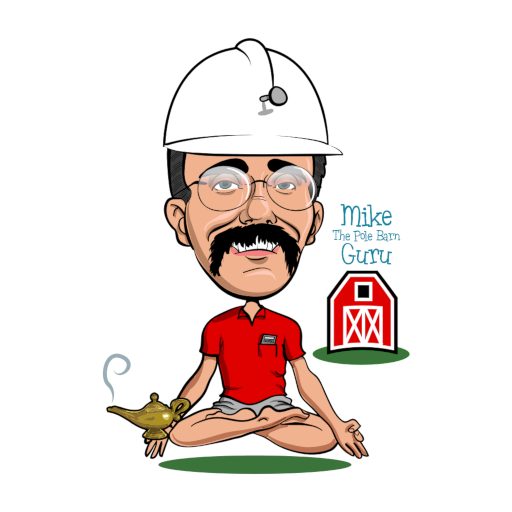In the summer of 1979, home interest rates began to rise. Idaho had a usury limit, home mortgages could not be written for 10% or more. When this ceiling was hit, home construction pretty much stopped in Idaho. I set out looking for other opportunities and ended up in Salem, Oregon.

In January 1980, the housing crunch I had fled from in Idaho hit Oregon. My truss plant, which typically produced 8 to 10 buildings worth of trusses a day, had only four orders in the entire month! Not good – however there was a single common denominator among those four orders, they were all for pole barn trusses. I didn’t have the slightest idea what a pole barn was, but it was time to find out. I picked the brain of a long time pole barn builder, George Evanovich, who explained the basics to me.
Now I have to confess, I was brought up with, “Wood is good”, so the entire concept of using roll formed steel for roofing and siding was a novel experience for me. Having convinced myself it had its place, we figured out material prices for some fairly typical pole barns and ran ads selling building kits. The response was overwhelming. By April, we were not only running the truss plant full time again (producing primarily pole barn trusses), we had also hired George and his two crews to construct buildings for our clients. By June, the truss plant was operating double shifts, just to keep up with the volume.
At 23, I thought I knew it all, and managed to get my walking papers by being over ambitious. I had all of 3 years of management and sales experience in the truss industry. I had bought lumber wholesale and sold to both builders and the general public. I had hired and fired 100’s of workers, dealt with subcontractors, routed trucks, etc. So of course I new it all, or thought I did at the ripe old age of 23. The owner had made it known he was considering stepping down and I threw my hat into the ring. However the owner’s son also worked there, as truck dispatcher. Short story was, the owner’s son got the position and I got a ride home in the company truck! Three years later the company was in bankruptcy. I “packed my bags”, took my existing truss accounts and was hired immediately at Mac Truss Company, in McMinnville, Oregon. I introduced them to pole barns and we started a pole barn supply. The pole barn kit business was good. One day in February 1981, I actually sold 13 buildings to 13 different customers in the same day! But sadly, it still was not enough to offset and overcome the debts from the truss operations and we closed in May. It was terribly depressing loading up the inventory on truck and watching them drive away.
With my final paycheck, I was able to pay our family bills current and had $50 left over. The local “free advertising” paper would allow me 3 weeks of credit, if I paid for the first week’s ad up front. I decided I couldn’t do any worse than the people I had worked for, and right then decided I was going into the pole barn kit business. Now granted, I had no business location, no inventory, no truck, no anything….all I had was an ad in the local free newspaper! The first week I sold three buildings, got down payments from the clients and… I was in business! One of my friends was in real estate and located six acres of highway frontage on Highway 99E just north of Canby, Oregon which could be rented reasonably. Paying first and last month’s rent, I now had a place. The Chevrolet dealership had ordered a lumber delivery truck for the local yard, who had not taken delivery on it. With a small down, they got me financed on the balance and I could deliver. M&W Building Supply Company was a reality!
Without the faith of two people, my fledgling business would not have survived. Jerry Garland, at Georgia Pacific, and Jim Betonte, at American Steel, got me credit terms to purchase materials. Without the ability to have been able to utilize them, I would have been sunk. The first year was not without its challenges. I could not afford a forklift, so I had to go pick up all the lumber, dump it off the truck at my “yard” and reload it back on the truck as needed to fill orders. The property I had leased included a 20’ x 40’ unfinished shop with a garage door in the back. Inside the shop, I could pound together roof trusses (up to 40’ long, when I opened the door), also loading them on the truck by hand. On slow days, I would move the inventory around the yard, by hand, a few boards at a time. Locals would stop by and comment, “Wow… business must be good.
Yesterday I saw you had piles of lumber ‘over there’….and today you have a pile….over here.” Yes, and I had moved the lumber 100 feet away by hand! When the phone would ring, a horn would sound outside and I would run like crazy into the office to answer. People thought I was busy, because I always sounded so out of breath.
We aren’t finished yet! Join Mike Momb in Part III – Evolution of The Pole Barn Guru and his Building Philosophy







We built our own template, thanks.
Thank you for providing this entry. I really enjoyed it. Keep up the quality work, man!
Keep up the quality posts
Your site has definitely inspired me to really completely re-think the way I blog. Just saying thanks for your hard work.
Nice post
Nice post. Thanks for sharing with us.